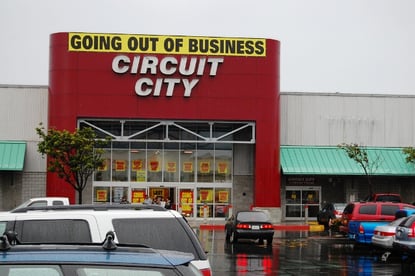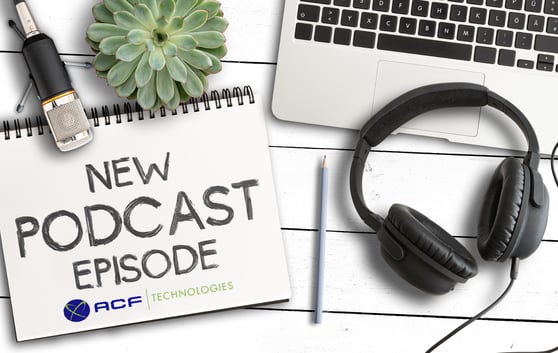The financial sector is in a clear time of transition. This is resulting in many challenges that are proving difficult to solve. Even for the larger financial institutions.
Many banks are trying to clean up their digital transformation strategy so that it does not interfere too much with the success of their physical branches. However, this is easier said than done.
An example of a company that failed to integrate any online strategy is Circuit City.
Listen to the Podcast
Circuit city had the best performing stock in the 1980s. They sold old school technology such as Hi-fi systems, and revolutionised in store customer experience, creating an exciting environment to test out this “state of the art” tech. However along came Best Buy and Amazon, both with a strong and efficient online service. They blew Circuit City out of the market. In 2008 they filed for bankruptcy, and the company began liquidation of its assets.

Ultimately, Circuit City became complacent, and the market shifted around them. Leaving them behind.
This use case is from 1994, however what we are seeing in the financial industry is somewhat the same. Large, multinational banks struggling to compete with online alternatives.
As they struggle, questions are raised. Such as “what level of physical branch ownership should we have?” “what are the roles of those branches?” “How would we manage customer experience preferences between the generations?" All these questions funnel back to the underlying digital infrastructure.
What approach will the financial industry likely take to save their branches?
The UK and Europe have seen a definite decline in footfall within traditional retail. That include retail banking. Online obviously has something to do with this. However, the answer is not to switch solely to digital. It does not solve the decline in footfall problem.
Simultaneously, you’re not going to stop people from shopping online. Instead, organizations could think carefully about bringing customers in for more meaningful experiences. With the same level – if not higher level of customer service.
Customer experience is very simple from a customer’s perspective. They just interact with you, how they want to. That could be physically, digitally or a combination of the two. What’s important is are you facilitating their preferences?
Have you got an example of any organizations doing this well?
Santander as a banking organization has done a great job of innovating in the right areas, utilizing various channels and different types of engagement as well. They have launched Cafes transforming some of their traditional branches or even sometimes flagship stores. They do have banking specialists on site but its primarily a social work space.
This is a fantastic example of innovation and experimentation that is paying off, resulting in a large organization utilizing its most expensive resources in a much more modern and effective manner.
 (Source: https://www.santanderworkcafe.co.uk/)
(Source: https://www.santanderworkcafe.co.uk/)
Do you think this is just the start of a new trend to solve a problem of reducing footfall?
The general direction of the financial industry does seem to be a reduction in the number of stores. However, the number of stores closing is often over inflated.
Banks need to ask themselves how many branches they have, how many they need and most importantly what role do the branches play. Work Cafes are very different to ATM only sites which do exist now. Both are as effective as each other at serving their purpose.
It has never been more important to clearly define the role of your branches, not just the services each is offering but the entire experience the customer will have, from the conversation with the Barista - to the fluidity of the appointment process with the advisers.
What do you think determines the different roles of these branches?
You can get very specific about this; advanced data analytics of each individual visiting a branch can aid in defining its audience. The very techy ATM only branches wouldn’t be too successful in a rural village with an ageing population. Thus face-to-face interaction will always be needed in retail to some extent.
Utilizing an appointment-based system is a must have for financial institutions right now. Meeting the consumers demands is all about being as convenient as possible. Giving the consumer the ability to determine their reason for visit, time and date and preferred adviser can really help banks cater each experience personally. Regardless of the primary role of said branch.
Should banks be putting together an enterprise event strategy?
Using in branch events at a branch level is a great way to make the most out of your resources, while driving face-to face meaningful engagement.
Promote an event and bring customers down to your local store for a first-time buyer event. Throw your mortgage specialist in to present it in one of his spare hours... That would be an amazing resource for customers, as most of us know - buying a house for the first time is quite intimidating.
This isn’t just appropriate for mortgage events but any kind of financial education.
Things they don’t teach us at school – Organizing your savings, getting a retirement fund in order, taxes and student loans, the list is endless. With the right infrastructure, you can experiment and see what works for each of your locations for a very low cost.
Companies need to redefine their branches. Personalize the customers experience and offer and invite them to meaningful, valuable engagements.
Not only will this boost brand trust massively – like what google achieved with their google digital garage workshops (free digital training for anyone available on the high street), it will also maximize the utility of the financial institutions most expensive resources, Physical sites and staff.
More episodes

Full episode transcript
Can Events Save the Branch from Dying?
Intro: Welcome back to customer experience conversations, over the next few episodes. We will be discussing challenges in the financial industry. In this episode we talk about how events could be saving banks from declining football.
Greg: Welcome everyone. This is Greg speaking here from ACF. I'm joined today by Louie and Adam. Hi guys. Today we're going to be talking primarily what are the challenges that we see the financial sector in particular are facing at the moment and just some of the ideas that we've got and we've implemented with our customers over the last year or two that helps try and mitigate and improve those challenges. We're going to start by maybe hearing some case studies from Louie. I know you found some really interesting case studies that sets a good baseline for this topic, but also, we can start to work down the long list of challenges that we've seen and like I say, started to help our customers try and solve those challenges. So quick introduction starting with myself. I'm one of the key account managers here at ACF and Adam and Louie, would you introduce yourself?
Louie: My name is Louie. I'm in marketing at the UK office.
Adam: I'm Adam Howarth recently started at ACF, also an account manager.
Greg: Perfect. So, Louie, earlier we were talking about that case study sort of story that you had, would you share that.
Louie: I just stumbled across an interesting example of a company that failed to effectively implement a digital transformation strategy and it was a company called Circuit City and they were actually the best performing stock in the 1980s, even though they only became public in 1984. So, it was quite impressive. They focused in like high five systems, computers, quite old school technology and they revolutionized customer experience. They had these stores where everyone could walk in and test out all of this technology, which was at the time it was quite an impressive experience. However, they failed digitization and because of that, companies like Best Buy and Amazon completely blew them out of the market. I think it was in 2008 Circuit City filed for bankruptcy and they began to liquidation. It's just interesting to see even a technology company like Circuit City failed their digital transformation strategy. So, it's not an easy thing to achieve. I was just thinking about how this could link into the financial industry. What examples have you seen of these kinds of problems in the financial industry? Like in banks?
Greg: Well, I think taking that use case, what year was that again, sorry?
Louie: That was in the 1980s.
Greg: The challenges faced with digital transformation in the 80s are not quite the same as the digital challenges that banks face today, hopefully. The challenges still remained nonetheless but I just think the challenges have evolved. So, it's no longer a question of whether you should or shouldn't have a website. That's maybe a question that organizations 10, 15, 20 years or whenever, that came about. Like I said, the challenges are different. I think if we look very focused in on the banking sector, especially in retail banking, large questions that face these organizations today are; ‘what level of physical branch ownership should we have?’ ‘What are the roles of those branches?’ ‘How would we manage customer experience between the generations?’ So younger generations are newer, not necessarily, but certain generations, certain customers really prefer online and somewhat don't prefer going into physical branches. Then you have different customer bases that really prefer that so that all then funnels back into the underlying digital infrastructure effectively behind a bank. Some of those are legacy systems that are very hard to change that, I don't envy the project manager that's got to manage from a very old data to CRM to a new one that's a very difficult project for example.
But there's a lot of new technologies as well that present challenges, technologies that can really transform customer experience to help, like I say, mitigate some of the risks that we'll talk about, some of the challenges that we'll talk about. So, I think rounding off everything of I'm saying here is the challenges that that organization faced in the 1980s around digital transformation were completely different to the ones that the banking sector face today. However, the challenges still remain, and I think a lot of those challenges, like I say, we would like to think in reality it's been cracked but actually it hasn't, it really hasn't. So many organizations I speak to today cannot do simple what we would consider being nice to have simple solutions from an IT perspective but simply cannot make it happen from an underlying architecture perspective. That might be a very generalized example. But I do think it's somewhat the case in the banking sector in particular.
Louie: What's interesting to see is if retail is going to start declining in banks is going to reduce in the way that it has in retail, retail obviously have approached it in their own way by using events. Do you think the same trend is going to repeat itself in the financial industry?
Greg: I think already has.
Adam: I think it has to.
Greg: Yeah, absolutely. I think we've seen over the last few years in particular, especially here in the UK is somewhat different across like Europe and then as you spread across the world it's definitely different. But here in the UK in particular and in Europe and some of the countries that we work with, there has been a general decline in footfall in the retail environment and whether that's retail banking, we also saw more traditional retail of all different types. I think we know that's because of the huge amount of opportunity to perform retail activities online. That's nothing new, that's been here for quite some years. So, with that, however, I think it doesn't present the question of how do we eradicate that problem because that problem is only going to be continuing. You're not going to solve that. You're not going to stop people shopping online or you're not going to stop people from utilizing online services. To me, it's a different question that organizations are asking themselves nowadays and it's how do we bring customers back to physical locations but for meaningful experiences. It's not about, “Oh no one's coming to the branch anymore.” People want to come to the branch in my opinion, but they want to come for the right reasons. They don't necessarily want to come for the reasons that you think they want to; sales or even service.
It's more about community experience, value added services I would say really is the driver now in retail and that follows completely through into banking. I don't really see a huge difference in my opinion anymore. I think what customers just think about us, we're all customers, right? Do you have in your mind, do you really have a massive different level of expected service when you walk into a bank to when you walk into any other retailer, a clothing retailer or anything like that? You probably expect the same level of service. Your telco provider, your phone provider, if you walk into one of their stores, banks, do you realistically expect any less of a service than if you walk in a retailer?
Adam: I personally think I would probably expect higher. I certainly wouldn't expect less. I think it should be a very efficient kind of experience. If I walk in and try on a tee shirt at Top man, I would imagine walking into my local high street bank should be a lot less chaotic, it should be easier . So, I certainly think you're spot on there, Greg.
Greg: Yeah, and I think that's an interesting dynamic that the world, we often talk about, for example, we often talk about Omni-channel, covering all the channels and that is a very important part of a strategy but to me it really, it's just one channel. A customer doesn't see channels with your organization. They just interact with you, how they want to interact with you. They don't really think of it in the same way that we sometimes perceive it as individuals to implement solutions on an Omni-channel environment or for the individuals out there who that is their responsibility to manage interactions with customers. The customer sees it to me in a much simpler way. I want to interact with you and your business; that could be physically, it could be digitally, it could be across any of the channels are you meeting me there? Are you able to serve me for my needs at that channel that's most convenient? And of course at that time that's most convenient as well. And I think that's an ever evolving challenge, but it does link back to quite heavily to me to the footfall challenge. That's quite a big part of it. The fact that there's a general declining in footfall in the retail world and we've implemented quite a few solutions in particular last few years that really have helped retail banks mitigate that.
Louie: You mentioned briefly about, what Santander they are doing, would you be able to tell me a bit more about that?
Greg: Sure. So. Santander era, to me is a really pretty good case study actually of, a banking organization that's doing I think a really, really good job of innovating in the right areas, utilizing various channels to engage with customers, utilizing different types of engagement as well. So, a good case study of theirs at the moment are the work cafes. So if you go online to Santander.co.uk and in several countries of course, Europe, they've launched work cafes transforming some of their traditional branches or even sometimes flagship stores, believe it or not, right in the center of town to actually branches that are, there's some hardware there does a couple of staff members, but primarily it's a work space.
Louie: Is it a cafe?
Greg: Yes.
Louie: Will they start serving coffee?
Greg: No, they have coffee there.
Louie: They’re taking on Starbucks?
Greg: Yeah, well maybe, but it's a completely different dynamic. Like to me that's a fantastic example of innovation that I think needs to happen right now. Because I do think there's an element in retail banking where it's about experimentation and I've really liked what's under there. I've done that and I think they've done a very good job of it as well and from what I can see it seems to be working pretty well.
Louie: It would definitely alter the experience with the brand instead of going into a bank and it's just you line up, you go to the teller, you get your money out, you may be asked a question about your bank account. It's more of a networking business approach, one-to-one experience with coffee. I really like that.
Adam: I think it’s a cracking idea. Maps, small business people that don’t have their own work place in the town or whatever, they have always in the past met at coffee shops, met at small hotels, those kinds of thing. Whereas if it's going to be a branch for your bank and if your bank offers that service then they're more likely to go into your branch. I think it's really great idea.
Louie: It’s a perfect example of a company trying to better utilize the resources it has. Of course, banks were trying to figure out like all retail stores, how many branches and how many people working these branches that they require. You see some companies closing a lot of branches, others are keeping them.
Greg: So, I think naturally we've seen that the general direction is a general reduction in the number of stores. I think it was maybe a bit inflated or a bit bloated if you want to use that term for a period of time where real estate was right in terms of just buying as many physical locations.
Adam: Santander used to be like that, incredibly didn't they?
Greg: Yeah. I think a good case study for that was Tesco. Can you remember at one point Tesco got told to reign it in because they were buying too much land? So, I think just for simply hitting the convenience factor, if it's convenient, people tend to lean that way and I think that's still very much true. But what's even nearer than a branch is your phone. So that mitigates that one a bit. So, you have to be careful with obviously having too much. And I think that's where the general direction has been is how many branches do we have? Number one, how many do we need? You can work out by using different data points, etc, but not just how many we need, it's about what roles those branches play. And I think that's something that has been happening in the last few years in the banking sector. I think a lot of organizations are still going through that transition, trying to work out the different types of branches that they have and the different roles that each of those branches play. And that can be ranging from your flagship branch to your work cafe as we had the example then all the way through to branches that don't have any staff at all. They're just ATM based branches. Where I live in Amersham there is a branch there that simply, you go through a door that opens and closes at certain time and there are simply a series of ATMs no staff at all.
Louie: Is it 24 hours then?
Greg: I don't actually know to be fair. I've not been down there, one in the morning or anything. For me though, the interesting thing is that you've got this ginormous range of branch type and I think that's always been there, but I think it's never been more important to really define the roles of your branches, not just in terms like I said, of the locations, but what are the services they're offering, what is the customer experience you're really signed to create in each of those? Because for that one, for example, you are trying to create completely different customer experience to one that is a flagship store.
Louie: What do you think determines the different roles of these branches? Maybe factors such as location or the demographics surrounding that branch maybe?
Greg: I think both of those plus probably loads of other variables that they factor in. There'll be so many different factors that you're looking at there to decide what branch, obviously the history of the branch, the history of the services offered in that area or the location.
Adam: Probably demographic, everything.
Louie: In a busy city you could have one of these 24/7 branches, but in a rural town with an ageing demographic, they're probably going to want some humans in their bank branch to chat with.
Adam: Yeah. Almost certainly.
Greg: Yeah, absolutely and I think it comes back to demographic again. It's one of the other challenges I guess that the banking sector really face is how do you personalize the experience? I'd say that's probably the second major trend to probably discuss today, but how do you personalize the experience more and one way that organizations have been doing that is to really define the branches, make sure the service that they offer are very much tailored to the audience, i.e. the local, the local people, the people using that branch etc. But there's lots of other ways that you can personalize the experience. Language, preferences, turn up, for example you obviously work with a lot of appointments solutions. Offering certain appointment types to individuals based on their needs. You can get very specific about that sort of thing. I think it's an interesting dynamic that the decline in footfall is really forcing organizations to really look at the basics. How many branches, where, what do they do, what do we offer? So that, to me, is an interesting one.
Louie: Yeah. I'm with you in that bank branches aren't going to die. I've seen a lot of articles online saying the bank branch is dead. It's all about digital currency. We don't need physical stores anymore, but I don't think that's the case at all. I think we're just in a stage of transition.
Adam: I think don’t think that's the case either personally going into a bank, into a branch, you obviously will go in there normally because you've got something that you need to do; paying cash, take out cash. But I think a lot of times, depending on your demographic and your education and in terms of what you're doing, whether it be buying a house, taking out a personal loan, I don't think you can get away from that kind of personal experience to see the whites of someone's eyes and I think you'll always need that. I think you will always need that. I think the challenge that obviously banks probably face is getting people in and encouraging them to actually do that rather than read online and go for those kinds of things. Greg briefly mentioned about appointments and solutions, I think banks in a weird way, they need to almost show themselves as educators as well and get people in to educate them on something like the different types of mortgages. When I first bought my first house, a long time ago now and at the worst time ever as well when the market crashed, I didn't really understand difference between trackers, fixed rates, whether I should take out a two year or five year, whatever. People now are more impatient. There's a lot of information online, but the ability to actually get yourself some dedicated time with someone who understands that, I think that will never go and the banks just need to be perhaps a little bit smarter about how they can encourage people into that.
Greg: Speaking quite openly, I think offering an appointment based system I think is crucial to that because naturally what you're doing is you're promoting a face to face interaction at a time that suits the customer, breaking it down to its simple level and it's fundamentally going back site and use it there is actually, if you look at why appointments are so successful in terms of their effectiveness is because in a face to face environment, number one things are more effective anyway but number two, if a customer books an appointment with you, there's a heavy buying signal in terms of he wants to know more, they are serious about learning more or wanting to buy your products or services or whatever it may be. So, it's not just appointments are nice to haves. To me they're absolutely crucial if you don't have an appointment system and it's not necessarily just appointments face to face in branches, that can be phone-based appointments, it can be video based appointments, even chat-based appointments. He agreed to speak with someone on a chat a certain time. Life is about convenience nowadays; doing things whenever it suits me best and we're all working towards that. But in the banking space in particular, appointments play a crucial role. That's one example. I think the second most important strategy that I'm seeing now in the financial space in particular is the rise of events and actually following on from appointments they just talked about and creating, creating those face to face interaction banks in particular. We work with a lot of customers at the moment in piloting these solutions and building these solutions out is really building sort of like an enterprise event strategy. So, looking at the branches, looking at the staff members you have, your physical locations and your staff are probably the two most expensive resources you have.
So it's about how do we make the absolute most out of those resources and one very effective way is to implement an in-branch event model that we've seen. And that's what we've been building out with a lot of our customers whereby you can look at your branches and entire estate and you can say how do we offer events at a branch level, local, flagship, all these types of branch we talked about. How do I better utilize those and actually promote events to local communities? Because you can very much localize an event. You can offer products or services or event topics that are very much front of mind for the people that live in that area using geolocation services and browsing history for example, and interactions online. It's not hard to work out trends of what people in a certain area are interested in. Why wouldn't you promote an event and bring customers down to your local store around those types of events. One of the misunderstandings of the events is that it's all about sales. It really isn't. From my experience, the majority of events are around education enablement; just informing your customers of good ideas, products or services. Adam talked about buying his first house. I know from speaking to several of the banking clients that we have, the most popular event types are a first-time buyer event. So popular because regardless of your age, wherever you are when buying your first house, it's a pretty intimidating experience, right?
Adam: Yeah. You're about to spend more money than you've ever spent before. You don't want to get it wrong.
Greg: Exactly. So, it's an intimidating thing to do and actually in reality to not have any face to face interaction around that is also scary. So therefore, offering events in a branch is something actually that is really going on well at the moment. We're seeing a huge uptake in first time buyer, first mortgage, application-based events. And like I said, it's just about educating a generation on all those things you talked about like mortgage rates and things like that.
Louie: So that seems to be the general direction of digital transformation strategy at the moment is educating the market on how to go about their finances effectively. And companies are using technology like appointment booking systems to facilitate this?
Greg: Yeah, absolutely.
Louie: That’s really interesting.
Greg: Their core strategies or their appointment strategies, event strategies, your branch strategy, your online, your call center strategy. They're all just strategies of a business to harness and maximize all customer engagements. I could say in a world where you have a declining footfall, one way to mitigate that is to promote events, bring customers back to branches for a meaningful reason. That's sometimes the hardest bit to find is the meaning in the interaction because why would someone come in to do this service in a branch when I can just do it online? There's that massive gap and some people do prefer that actually, to always go in branch but a lot of people don't nowadays it's so much quicker, so much easier.
Adam: I was shocked the other day because, you guys know this, but I didn't realize that now we have a lot of banks that you could even pay a check in on your mobile app. Did you know that?
Greg: No, I didn't know that.
Louie: How do they do that?
Adam: You literally take a photograph of the check on your app and it clears within a day. You could argue actually that's fantastic because obviously one banks come up with that, so everyone has to do it. But if anything, that's actually, again, taking football away from the banks because someone like me who doesn't often go into a bank now and I need to go in because my Nan gave me a check for 8 pounds 50 or whatever. I can just do it on the app. I think those solutions are fantastic and people love them, but they also can be kind of counterproductive because that'll take football away from the bank. If it can be done on a mobile phone, why do I need to come in?
Greg: That links back to the idea that it's about redefining what is meaningful to your customers. Like events to educate customers on how to buy a first-time mortgage that has a lot of meaning that will pull people into your branch for sure. Cause it is right now for loads of banks out there. You go on to a lot of websites and it’s really working. That is a strategy we're seeing this absolutely working.
Adam: It does even have to be mortgages either, it could be savings, it could be looking after your estate and your retirement fund, taxes, whatever and these are all things that if they went to source that knowledge privately it would cost them money.
Greg: Yeah. We're talking about piloting event strategies with like Telco’s, etc. At the moment where it's all about educating people on home security products that they sell. They are telco but they sell home security based products and that's a pull factor, that’s a hot topic that really is able to create a meaningful experience because you would physically go to a store, have that face to face interaction, learn about that particular spot and just have you come away feeling empowered and that's something that is very hard to communicate as effectively, in my opinion, online. Going back to what you said earlier, Louie, face to face definitely has its role to play, but it's about really looking at the services you offer and saying, well what is meaningful? What is a meaningful experience face to face today? If you can do things online like doing checks and stuff like that, that's one less reason like you say to come in, but there are still a thousand other reasons why customers should be visiting and why customers will want to visit your physical branches.
So that's the second point we talked about. So, the first one was like a declining footfall. The second was the idea that the redefining of the branch is helping personalize the experience and I think actually event plays a key role in that as well in particular about offering and inviting customers to events on a very one-to-one level. If you're interested in a particular product or service and you've shared that interest with your bank, there's no reason why they can't invite me as Greg or you as Adam or you as Louie to your local branch. You can get very highly targeted with certain strategies like appointments or events. And I think maybe the third and sort of final one to discuss today in terms of a challenge that I've seen in particular the last, I say couple of years, is the need to really increase the utilization of the resources you have at hand. We touched on this a little while ago around better using your branches and your staff. And this actually to me is a huge, a huge driver right now in the banking sector. Like we talked about, staff and branches are probably your biggest overhead, but to me around the actual physical locations, things like events obviously help increase the utilization of those. So, you can host events during your working hours, you can host events, obviously after your working hours, there's no reason as to why you can't. And from a people perspective, you've got the idea that you've got all these knowledgeable people, extremely knowledgeable and skilled individuals. You can surely use those people more effectively. If someone's standing around in a branch not serving a customer, they're being underutilized. Bottom line, that's the truth of the situation.
So how can you better utilize them? Well, again, going to the events example, not to use that as the only example, but why not schedule them in to host an event. If they're a mortgage specialist, get them to host an event with customers, invite customers to that event and say, “from four till five on next Thursday you're going to be hosting your own event, you're the specialist, you're going to have five, six, 10 customers in the branch. Maybe if we promote it well enough, customers will come in. They will come in and you can host your own event.” So it's about using those resources that you have sometimes better but not necessarily adding new resources. There's so much talk of adding this or the branch by technology platform and adding this one and adding that one and AI and facial recognition. There's a million things out there, but actually sometimes it's just using what you've got at your fingertips a bit better and just thinking slightly about, ‘okay look, we've got this system here and we've got these people and we've got these branches. How can we create something a bit more interesting for our customers?’
Adam: Yeah. I think there's a big long list of challenges that bank face, but to me those three at the moment are three massive hot topics are declining football, a need to personalize the experience and how can organizations better utilize what they already have rather than getting caught up in a million new and innovative ideas but I hope we've also shared some ideas.
Greg: We'll come back to this. I think there's a part two and maybe a part three in the future if you want. Thanks for listening everyone. Hope this has been valuable and insightful and we'll speak again soon.







